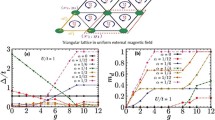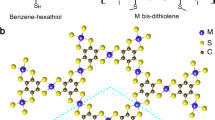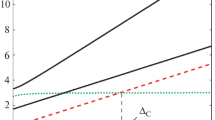Abstract
The magnetic molecular conductor λ-(BETS)2FeCl4 shows metal–insulator (MI) transition and antiferromagnetic (AF) transition simultaneously at TMI ~ 8.3 K. In its metallic phase, two Fermi surfaces coexist, and the one has good nesting, and the other has bad nesting. Although a scenario of the MI transition by the formation and stabilization of a spin-density-wave (SDW) AF order is likely, it is not straightforward due to the existence of the bad nesting Fermi surface. In this paper, we propose a novel mechanism for the MI transition motivated by this material. Our proposal is based on the square-lattice two-band t − t′− U Hubbard model at half-filling, and we examine this mechanism in the ground state. As the key part of our mechanism, we incorporate the interband exchange interaction between the band A with good nesting Fermi surface and the band B with bad nesting Fermi surface. We analyze B, incorporating the electronic correlation effect into the quasi-particle weight by the slave-rotor approach. In this model, as the value of U∕t increases, the SDW state in A induces another SDW state in B via the interband exchange interaction. As a result, this exchange interaction significantly decreases the value of U∕t required for the MI transition.
Graphical abstract

Similar content being viewed by others
References
J. Hubbard, Proc. R. Soc. (London) A 276, 238 (1963)
J. Hubbard, Proc. R. Soc. (London) A 277, 237 (1964)
J. Hubbard, Proc. R. Soc. (London) A 281, 401 (1964)
A. Georges, G. Kotliar, W. Krauth, M.J. Rozenberg, Rev. Mod. Phys. 68, 13 (1996)
M. Imada, A. Fujimori, Y. Tokura, Rev. Mod. Phys. 70, 1039 (1998)
E. Fradkin,Field Theories of Condensed Matter Physics, 2nd edn. (Cambridge University Press, Cambridge, 2013)
H.Q. Lin, J.E. Hirsch, Phys. Rev. B 35, 3359 (1987)
J.R. Schrieffer, X.G. Wen, S.C. Zhang, Phys. Rev. B 39, 11663 (1989)
Y. Ran, F. Wang, H. Zhai, A. Vishwanath, D.-H. Lee, Phys. Rev. B 79, 014505 (2009)
W.-H. Ko, P.A. Lee, Phys. Rev. B 83, 134515 (2011)
H. Kobayashi, H. Tomita, T. Naito, A. Kobayashi, F. Sakai, T. Watanabe, P. Cassoux, J. Am. Chem. Soc. 118, 368 (1996)
H. Cui, H. Kobayashi, A. Kobayashi, J. Mater. Chem. 17, 45 (2007)
H. Kobayashi, A. Kobayashi, H. Tajima, Chemistry 6, 1688 (2011)
L. Brossard et al., Eur. Phys. J. B 1, 439 (1998)
T. Mori, M. Katsuhara, J. Phys. Soc. Jpn. 71, 826 (2002)
M. Terao, Y. Ohashi, Physica C 412, 324 (2004)
S. Uji, H. Shinagawa, T. Terashima, T. Yakabe, Y. Terai, M. Tokumoto, A. Kobayashi, H. Tanaka, H. Kobayashi, Nature 410, 908 (2001)
L. Balicas, J.S. Brooks, K. Storr, S. Uji, M. Tokumoto, H. Tanaka, H. Kobayashi, A. Kobayashi, V. Barzykin, L.P. Gor’kov, Phys. Rev. Lett. 87, 067002 (2001)
O. Cépas, R.H. McKenzie, J. Merino, Phys. Rev. B 65, 100502 (2002)
H. Akiba, S. Nakano, Y. Nishio, K. Kajita, B. Zhou, A. Kobayashi, H. Kobayashi, J. Phys. Soc. Jpn. 78, 8 (2009)
T. Kobayashi, A. Kawamoto, Phys. Rev. B 96, 125115 (2017)
C. Hotta, H. Fukuyama, J. Phys. Soc. Jpn. 69, 2577 (2000)
H. Aizawa, T. Koretsune, K. Kuroki, H. Seo, J. Phys. Soc. Jpn. 87, 093701 (2018)
M.C. Gutzwiller, Phys. Rev. Lett. 10, 159 (1963)
M.C. Gutzwiller, Phys. Rev. 134, A923 (1964)
M.C. Gutzwiller, Phys. Rev. 137, A1726 (1965)
W.F. Brinkman, T.M. Rice, Phys. Rev. B 2, 4302 (1970)
S. Florens, A. Georges, Phys. Rev. B 70, 035114 (2004)
L. de’Medici, A. Georges, S. Biermann, Phys. Rev. B 72, 205124 (2005)
H. Shimahara, Y. Kono, J. Phys. Soc. Jpn. 86, 043704 (2017)
Author information
Authors and Affiliations
Corresponding author
Additional information
Publisher's Note
The EPJ Publishers remain neutral with regard to jurisdictional claims in published maps and institutional affiliations.
Rights and permissions
About this article
Cite this article
Konishi, E., Sato, S. & Morinari, T. Spin-density-wave-induced metal–insulator transition in two-band Hubbard model in application to the magnetic molecular conductor λ-(BETS)2FeCl4. Eur. Phys. J. B 93, 171 (2020). https://doi.org/10.1140/epjb/e2020-10203-6
Received:
Revised:
Accepted:
Published:
DOI: https://doi.org/10.1140/epjb/e2020-10203-6




